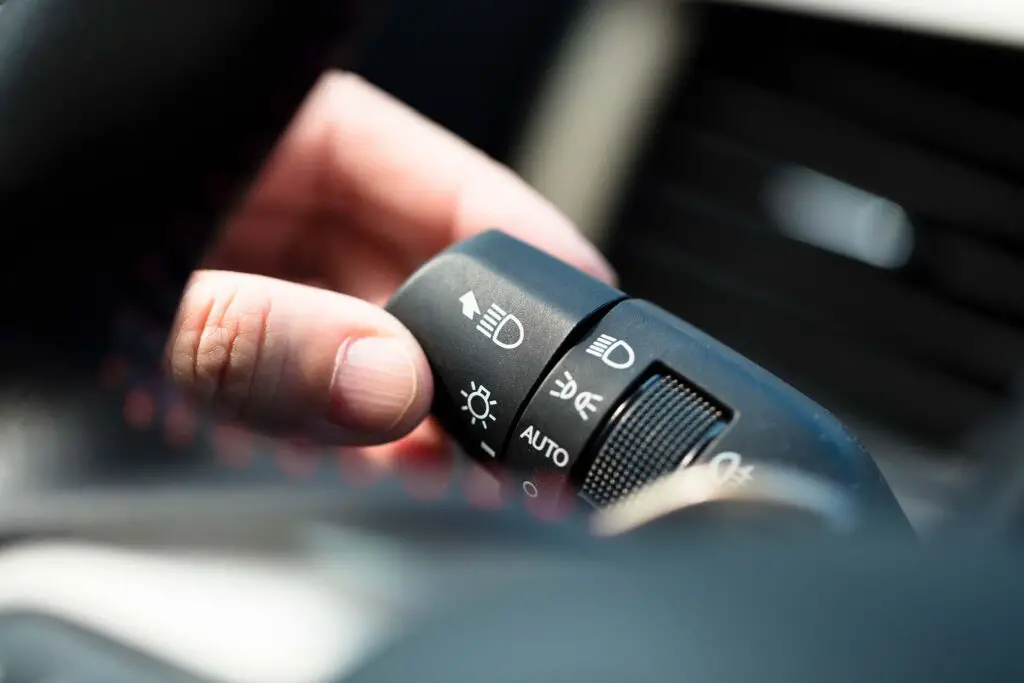Lights on a car are crucial. In many countries around the world, laws state that headlights must be on at all times, and the fines in case of a malfunction are pretty big. To avoid light problems, you must learn to recognize the signs of a bad headlight switch and check it for yourself if necessary.
What Is a Headlight Switch?
The headlight switch, often called the dimmer switch or just dimmer, is a switch inside the car that controls the headlights and their brightness. The switch is on the steering dashboard, on the left side of the steering wheel. It’s also often attached to the steering column on the left of the wheel (the left handle controls the headlights, and the right one controls the windshield wipers).
There are also computer-controlled headlight systems, which engage the lights as soon as the car turns on. This allows the driver to think about other things and not worry about switching the lights on or off.
Still, most cars currently have a switch; older models have it as a knob they can dial from left to right, and newer ones have it on the steering column as a handle.
How Important Is It?
Lights are crucial for safe driving, so the headlight switch plays one of the most important roles in a car. It may not be as important as the correct spark plugs or a frequent brake fluid check, but it’s still a massive part.
Why are lights so important? Well, firstly – they make driving at night possible and safe. Secondly, many countries in the world have made it legally mandatory for drivers to keep their lights turned on at all times, even during the day.
If a driver doesn’t abide by these rules, if they get caught, the fine is usually astronomical. A small error can cost you a lot, so don’t overlook this crucial vehicle component when driving. However, remember that the lights drain the car battery, so don’t keep them on while your car’s off.

What Types of Lights Exist on Cars?
Before learning about the signs of dimmer switches malfunctioning, it’s important to understand what kind of lights they control. There are several options on the dial, and all play a crucial role in ensuring your safety and driving efficiency.
The lights and light modes on a car are:
- Headlights – these are high and low beam lights. Low beams are the standard light setting that illuminates the road or path. High beams are the brighter and longer version of the low beams. Use low beams when driving at night and in busy traffic; use high beams when driving at night and on long road stretches with scarce traffic,
- Daytime running lights (DRLs) – these are automatically activated bright front lights, but not as strong as the low beams. DRLs are mandatory, and all cars manufactured in 2011 and later have this mode,
- Sidelights – these are dim lights that can be found in the headlamp units; they’re also known as parking lights, and they activate the tail lights and the license plate bulbs,
- Fog lights – these include front and rear fog lights. The rear consists of a single or double red light; the front includes small white lights, low-set in the bumper area. The symbol for them is a light with crossed-over beams.
- Automatic settings – some cars have this setting, and it’s there to let the vehicle determine which lights are best in certain situations; the car needs a sensor for this, so it’s typically included in newer models,
- Light controls switch – this is part of the lights, but it’s not a mode. It’s an indicator that appears on the dashboard, usually in yellow or orange. When you see a lightbulb on the dash, something’s up with the lights.
What Are the Signs of a Bad Headlight Switch?
There are several signs of a bad headlight switch, and they’re all pretty obvious. If you experience issues, you’ll be able to tell immediately, similar to a car thermostat malfunction. Not all car problems manifest as obviously as a bad dimmer, so being able to tell early is quite lucky.
The three issues below are the most common dimmer switch malfunctions, and they can appear one at a time or simultaneously. You must take your car to a mechanic as soon as you notice one or more of the following signs.
Mode Switching Problems
Dimmer switches have several modes. The mode on the far left (on dial switches) or at the bottom (handle switches) is where you turn off the lights. Some cars also have an automatic mode right beside the off switch.
After automatic mode, there are the low beams, and on the far right end or the top are the high beams. Suppose you want to transition from high to low beams, but the dimmer doesn’t make the switch. In that case, you’re likely experiencing a bad headlight switch.
Besides the transition from one mode to another malfunctioning, it could also cause the lights to flicker or turn on and off often. If the lights turn erratic, the time has come for a visit to a professional mechanic.
High Beams Not Functioning
Now that you know what high beams are, you also know what they look like compared to low beams. You probably noticed that while driving, even if your car’s headlights are frequently set to automatic.
Despite that, you’ll always know if your car’s on a high beam setting because of the dimmer switch. The symbol for high beams looks like a lamp with the rays shooting straight out. If, when transitioning from low to high beams, the light doesn’t change at all, you might be having dimmer issues.
The difference between the low and high beams is apparent, and if there’s no change upon turning the dimmer switch, it would be good to check its health. The mechanism uses a lever that changes the lights, but it’s connected to the dimmer.
The Lights Don’t Work
When you hit the headlight switch, the lights should turn on – simple as that. You’ll know you have a real problem if the lights do nothing after you turn the switch. You can turn the dial quickly back and forth, but that’s not going to work because that’s not how these switches work anyway. Don’t pretend things like that help when they can only do harm.
One or two turns of the switch should be enough. Make sure to turn your car on before attempting this; the lights are connected to the car battery and only work if this component is engaged.

Is It Difficult to Replace or Repair?
A headlight isn’t difficult to replace or repair, but you must be careful when doing it independently. You could be dealing with live electricity even if your car is turned off. This is because the switch is on a circuit connected to the car battery.
There are different types of headlight switch systems connected within the car. Checking the lights will depend on them, as some are more complicated than others. Still, if you know a bit about this and do intend to test your headlight system alone, here are the tools you’ll need for that:
- Screwdriver,
- Socket,
- Ratchet,
- Trim removal tool,
- Service or repair manual,
- Multimeter,
- Multimeter wire probes.
How to Test Your Headlight Switch
The testing of your headlight switch will include some dismantling of the car’s interior. For example, removing the knee bolster below the dashboard is one of the things you’ll have to do on certain models. On others, you’ll be removing the steering column covers.
A lot will also depend on the kind of supply system your light switch is attached to. There are three options:
- 12-volt supply system,
- Ground supply system,
- Computer-controlled system.
If You Have a 12-Volt Supply System
The switch in this kind of system is powered by a 12-volt, low-current source. The switch transmits this power supply to the controls on the headlight relay when the headlights are turned on. A higher-current circuit is activated by the relay, and power is then delivered to the headlights. This way, the dimmer switch doesn’t fail prematurely due to heat.
If the parking lights function but the headlights don’t, the relay may be broken. For this, you can try replacing the relay in your fuse box with another, similar one. Besides that, you might need to determine which wiring needs to be tested and test the voltage at the switch.
For the former, use your car manual and determine the way the wires are set up. That way, you can determine which wires supply voltage to the relay, which to the parking lights, and which to the high beams.
For the latter, find the ground wire in the wiring harness and use the negative lead of the multimeter on it. This ground wire could be below the dash, in the firewall, or behind the driver kick panel. If you see voltage displayed on the multimeter, something else is likely at fault.
If There’s a Ground Supply System
In this kind of circuit, the switch only provides the headlight relay with a ground connection. If your car’s circuit was built this way, you’ll see on the wiring diagram that the relay has two constant power sources and that the ground side connects to the headlight switch.
In this situation, you’ll need to identify the ground and output wiring, check for constant grounding, and test the switch for continuity. In the first case, you’ll need to find the wire connecting directly to the body ground. You can find it when looking for three dashes at the end of a wire.
You’ll need to find a power source and probe it with the multimeter’s positive lead. The negative lead can test the grounded wire. If you don’t notice a voltage reading, fix the switch’s constant ground position and make sure the headlights are working properly.
If Your System Is Computer Controlled
In this kind of system, the body control module (BCM) does the bulk of the work. The BCM supplies a 5-volt reference to the switch; the signal returns to the BCM when the switch is in a parking or headlight position.
The BCM controls the headlights directly or functions as a controller for the headlight relay. Testing this system is similar to testing the 12-volt one, except here, you can also test for reference signals and output.

Checking Your Headlight Switch Alone Poses Risks
Since checking for electrical signals can prove dangerous when doing it alone, it’s crucial to take the necessary precautions. These precautions include:
- Since you’re working an electrical circuit, be careful of every step you take,
- Never cross a power and ground circuit,
- Keep your car turned off at all times while doing the repairs,
- Before checking the results of your work, remove the negative battery cable first,
- Do not remove insulation from the wires.
Take Your Car to a Professional Mechanic If There’s a Problem
While checking whether your headlight switch is good or bad, you may have to work with an electrical circuit. This immediately poses a risk, as getting electrocuted is a high possibility and an unwanted occurrence at best.
To avoid prodding around your car’s dashboard and systems, take your four-wheeler to a mechanic. This won’t just help you stay safe; it’ll also give you results of a job well done, and you’ll personally avoid causing other kinds of damage to your vehicle. Lights are crucial, but your health matters more.








